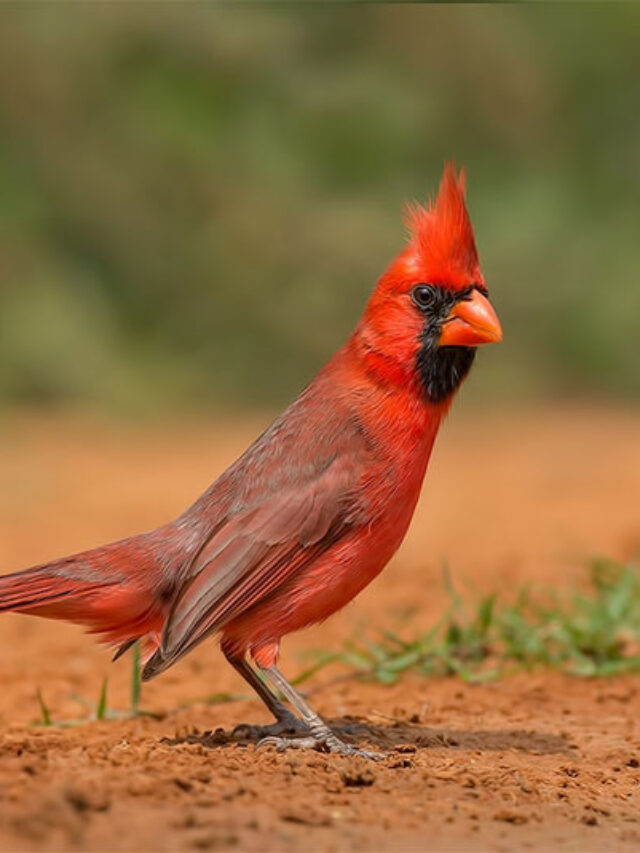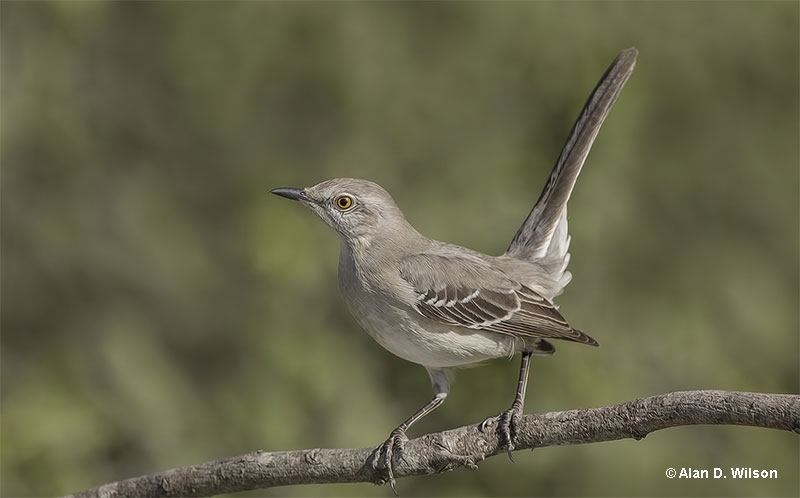
Did you know that Florida has 538 species of birds? If we also count escaped and exotic birds, the number of birds in Florida jumps to 552 species!
Florida’s warm and beautiful weather isn’t just popular among people. Birds love it too!
The birds of Florida thrive in the state’s warm, subtropical climate and 65,758 square miles of wetlands, prairies, swamps, and woodlands.
Although the Grasshopper Sparrow and a few other, very habitat sensitive species have declined, the majority of birds are still common and easy to see.
There’s a lot of birds in Florida but what about identifying them, especially the most common species?
Based on real data, this up to date list will help!
On this page
- Most Common Birds in Florida
- Northern Cardinal
- Red-bellied Woodpecker
- Mourning Dove
- Northern Mockingbird
- Blue Jay
- White Ibis
- Great Egret
- Carolina Wren
- Fish Crow
- Osprey
- Turkey Vulture
- Blue-gray Gnatcatcher
- Red-shouldered Hawk
- Great Blue Heron
- Palm Warbler
- Boat-tailed Grackle
- Tufted Titmouse
- Anhinga
- Downy Woodpecker
- Little Blue Heron
- Common Grackle
- American Crow
- Red-winged Blackbird
- Double-crested Cormorant
- Snowy Egret
- Black Vulture
- Tricolored Heron
- Gray Catbird
- Laughing Gull
- Common Gallinule
- Yellow-rumped Warbler
- Pileated Woodpecker
- Northern Parula
- Carolina Chickadee
- Brown Pelican
- What Are The Best Ways To Attract Backyard Birds?
- What Are The Best Places To Watch Wild Birds?
- Frequently Asked Questions about Birds of Florida
Most Common Birds in Florida
Which are the most common birds in Florida? To find out, we reviewed the latest eBird data to show the most frequently seen species, and ordered them from most common to least common.
To help recognize them, we also included accurate information about their behavior and identification.
Remember that the birds at the end of the list are common and easy to see too!
Northern Cardinal
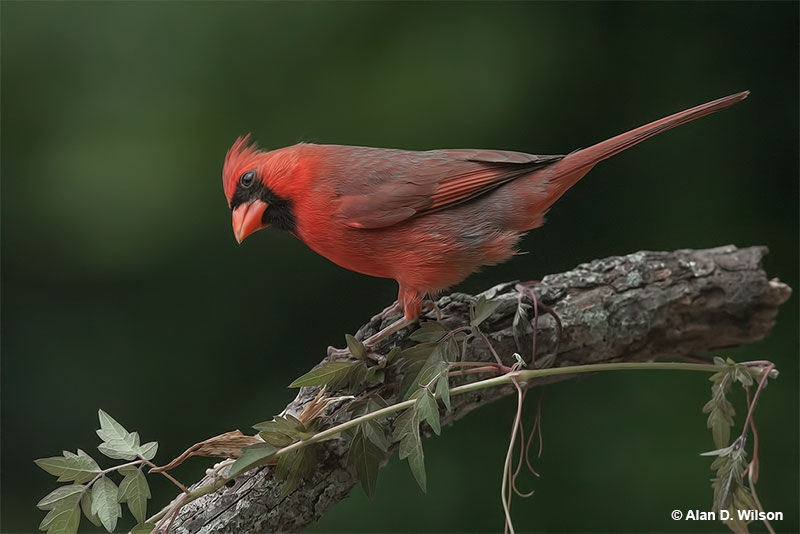
The Northern Cardinal is one of the most common birds of Florida.
Scientific name: Cardinalis cardinalis
Length: 8.75 inches
Weight: 1.6 ounces
Wingspan: 12 inches
Song: “pichew-pichew-pichew, chew,chew,chew,chew,chew”
Northern Cardinals are medium-sized songbirds with a perky crest and big orange-red beak. Males are bright red with a black throat and face, and have dusky red on their back, wings, and tail.
Female Northern Cardinals are grayish-brown and buff with some black on their face and throat. They also have red highlights in their crest, wings, and long, rounded tail.
This species has short, rounded wings and seems to bounce up and down as they move through the air. In flight, Northern Cardinals also make sharp chip notes.
The Northern Cardinal is a bird of second growth, gardens, and parks. It eats seeds, insects, and some fruit and is a regular visitor to bird feeders. They forage on and near the ground but males sing from a prominent perch.
This beautiful bird occurs in pairs and nests in bushes and low trees. They can be spotted year-round in Florida.
Key Identifications:
- Crested bird with a conical orange-red beak and a black face. Males are red, females are grayish-brown and buff.
- Forages for seeds and insects on and near the ground.
- Makes a cup-shaped nest in bushes and low trees.
- Sings a clear, whistled song of repeated notes. They can sound like “cheer, cheer, chew, chew, chew, chew” or a quick “birdee,birdee,birdee,birdee,birdee“. They also make loud, sharp chip notes.
Northern Cardinals are one of the most beautiful common birds in much of their range. It’s no wonder seven different states chose it to be their official bird.
Red-bellied Woodpecker
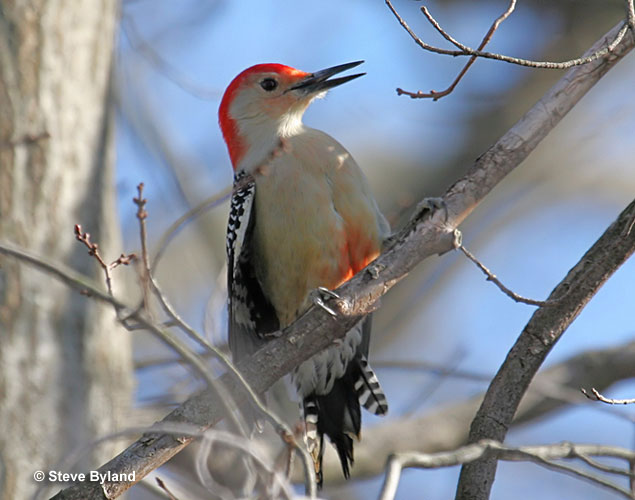
Scientific name: Melanerpes carolinus
Length: 9.25 inches
Weight: 2.2 ounces
Wingspan: 16 inches
Song: “Qwerr!”
Red-bellied Woodpeckers are medium-sized with black and white barring on their back and wings. They have a long beak and pale gray underparts with a small red patch on the belly.
Males have red on the head from the bill to the back of the neck (the nape). Females have an orange-red spot above their bill and red on the back of their head. Both sexes have a mostly white rump and central tail feathers.
This woodpecker species has long wings and “undulating” flight, where it moves up and down as it flies. In flight, Red-bellied Woodpeckers show a small white patch in their wings.
The Red-bellied Woodpecker lives in wooded habitats. It eats nuts, seeds, insects, fruit, and can attack nestlings of other species. It also visits bird feeders.
See more: Most common woodpeckers in Florida (& how to ID)
This striking woodpecker occurs in pairs and nests in tree cavities high above the ground. They are common birds of Florida.
Key Identifications:
- Grayish woodpecker with black and white barring above, and red on the top of the head and back of the neck.
- Forages for seeds, nuts, insects and other food on trunks and branches.
- Nests in a tree cavity, high overhead.
- Makes a loud exclamation, “Qwerr!“. It also makes other, briefer and quieter “chug” calls.
Red-bellied Woodpeckers are common and adaptable birds. As long as big trees are present, we see them in urban areas as well as wilder places. They also visit feeders and have a very long tongue. When extended, it sticks out 2 inches past the tip of its bill!
Mourning Dove
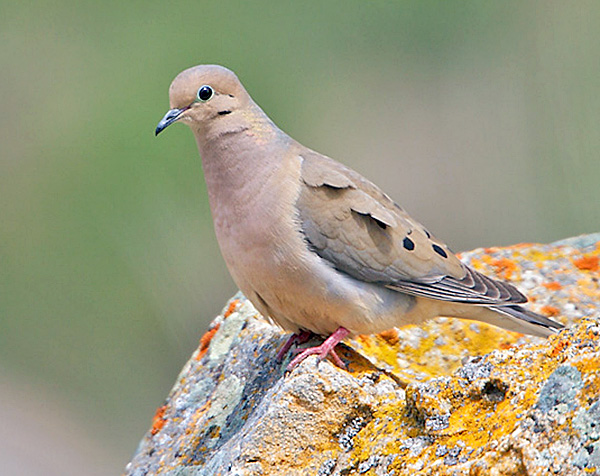
Mourning Dove is one of the most common birds of Florida. Photograph © Greg Lavaty.
Scientific name: Zenaida macroura
Length: 12 inches
Weight: 4.2 ounces
Wingspan: 18 inches
Song: “hooOOA, hoo, hoo, hoo”
Mourning Doves are medium-sized, grayish-brown doves with long tails. They have small black spots on their wings and a small head with a slender, dark beak.
Males and females also have narrow gray eyerings, a black mark on the face, and pale iridescent gold on the sides of their necks. They look alike except for males having more gray on the head and neck, and more iridescence.
This dove has fairly long wings and swift, direct flight. When flying, it shows black and white in its tail.
The Mourning Dove occurs in woodlands, gardens, on farms, and in urban areas. This common feeder visitor eats seeds and grains. It also forages in open situations, picking food from the ground.
This pleasant dove species can visit a feeder on its own or forage in small flocks. It builds an unkempt stick nest in bushes and trees and is very common throughout Florida.
Key Identifications:
- Plain brown and gray dove with a long, pointed tail.
- Feeds on seeds at feeders and on the ground in open areas.
- Makes a small, messy nest of sticks in trees.
- Sings a sad and owl-like “hooOOA, hoo, hoo, hoo”.
The Mourning Dove is the common garden dove in most of its range. It often visits feeders and its cooing song is commonly mistake for an owl. This species has a short lifespan with many adults only living for a couple of years or less.
Related: All 11 Owls in Florida
Northern Mockingbird

© Alan D. Wilson
Scientific name: Mimus polyglottos
Length: 10 inches
Weight: 1.7 ounces
Wingspan: 14 inches
Song: “kerdee, kerdee, kerdee…jirdle,jirdle,jidrle…”
The Northern Mockingbird is a pale gray and white bird with a long tail. Around the same size as an American Robin, it has a dark line through a pale eye, a short, slender beak, and two white wing bars.
Both sexes look alike, are gray above, and white and buff below. In flight, this bird shows a blackish tail with white outer feathers and a big white wing patch.
Northern Mockingbirds feed on insects and berries. These animated birds run and pick bugs from the ground and fly up to catch insects in flight.
The Northern Mockingbird lives in towns, parks, and other semi-open habitats, and builds cup nests in bushes and low trees. Northern Mockingbirds are common garden birds in much of the eastern and southern USA, southern Ontario, and Mexico.
Key Identifications:
- Vocal, gray and white bird with a small bill, white wing patches, and a long, black and white tail.
- Feeds on the ground in open areas and in bushes. Mostly eats insects and berries.
- Makes a cup nest in a bush or low tree.
- Very vocal. Sings many phrases and mimics many other birds. Some of the more regular phrases sound like, “kerdee, kerdee, kerdee…jirdle,jirdle,jidrle…“. These are interspered with the calls of Blue Jays, woodpeckers, Tufted Titmouse, and various other bird species.
The Northern Mockingbird is a common and conspicuous bird. They are also known as the state bird of Florida.
This species can mimic the calls of 35 bird species as well as mechanical sounds. More than a century ago, these avian virtuosos were highly prized as a cagebird and were traded for large sums of money.
Blue Jay
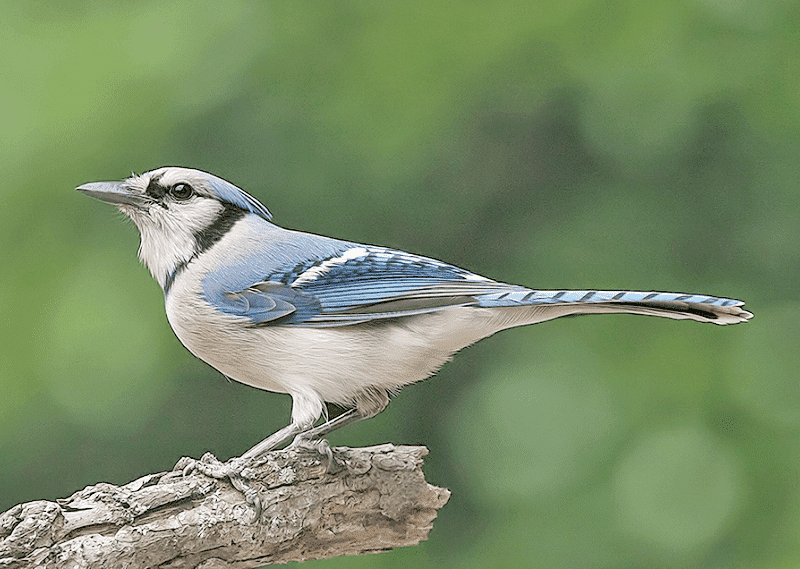
Blue Jay is a common bird in Florida. Photograph © Alan Wilson.
Scientific name: Cyanocitta cristata
Length: 11 inches
Weight: 3 ounces
Wingspan: 16 inches
Song: “Nyeah! Nyeah! Nyeah!”
The Blue Jay is a fairly large, crested bird with a straight black bill. Both sexes look alike and are blue above and gray and white below. They also have some small black lines on their faces and a narrow black necklace that goes up to the side of their face and crest.
Blue Jays also have some white markings and black barring in their wings and on their tail. Young birds look like adults but are duller blue.
These social and intelligent birds feed on acorns, nuts, insects, and other small creatures. Like other members of the jay and crow family, they eat the eggs and nestlings of other birds.
The Blue Jay is a common bird of woodlands, forest, and towns east of the Rocky Mountains in the USA and central and southern Canada. They are common birds of Florida.
Key Identifications:
- Crested, fairly large bird with bright blue above and gray below.
- Feeds in trees and at feeders. Eats acorns, nuts, insects and many other food items.
- Makes a messy cup nest of sticks in a tree.
- Very vocal. In flight, Blue Jays often call as they swoop through the trees. They make a variety of sounds and mimic some other birds. Common calls include a nasal and complaining “Nyeah! Nyeah! Nyeah!” and various whistled calls.
The Blue Jay is a common, intelligent, and noisy bird. They make their presence known with their loud calls and can visit feeders. Ironically, when communicating with each other at close quarters, this species makes much softer and quieter calls. It’s almost as if they are talking with each other!
White Ibis
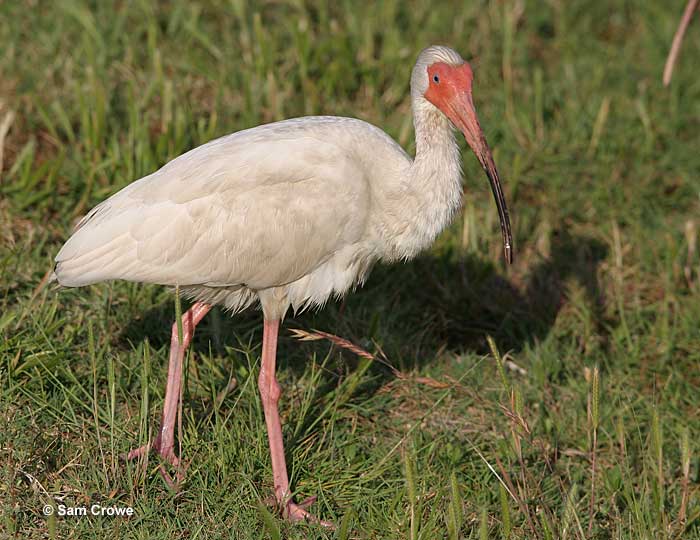
Scientific name: Eudocimus albus
Length: 25 inches
Weight: 2 pounds
Wingspan: 38 inches
Song: “whaah”
The White Ibis is a fair-sized, white waterbird with a long, decurved red bill, and long red legs. Males and females look alike and also have a bare red face, and pale eyes.
In flight, these birds show long, broad wings with black wingtips, and short, broad tails. Young birds have grayish-brown on their head and neck, and dark brown on the back, wings, and tail.
The White Ibis often occurs in flocks of a dozen or so birds. They feed on frogs and other small aquatic creatures as well as other food they find and catch. This bird forages by wading in shallow water or other wet places and probing the wet ground with its beak.
It nests in colonies and builds a messy stick nest in trees and thickets. These social birds are common species in and near wetlands in the southeastern USA, Mexico, parts of the Caribbean, Central America, and northern South America.
Key Identifications:
- Fairly large white bird with a long reddish beak and long, red legs. Young birds have brown in their plumage and an orange beak and legs.
- Feeds on the ground, in and near wetlands. Eats frogs and other small creatures caught with its long bill.
- Makes a bulky stick nest and nests in colonies.
- A quiet bird. The White Ibis isn’t very vocal and only makes occasional nasal and guttural sounds. “Whaah, Whaah“.
The White Ibis is a common, easily seen bird of coastal habitats and wetlands. Small flocks often wade in shallow water and forage together. Although their bill is red, because they use it to probe in the muddy ground, half the beak often looks blackish.
Great Egret
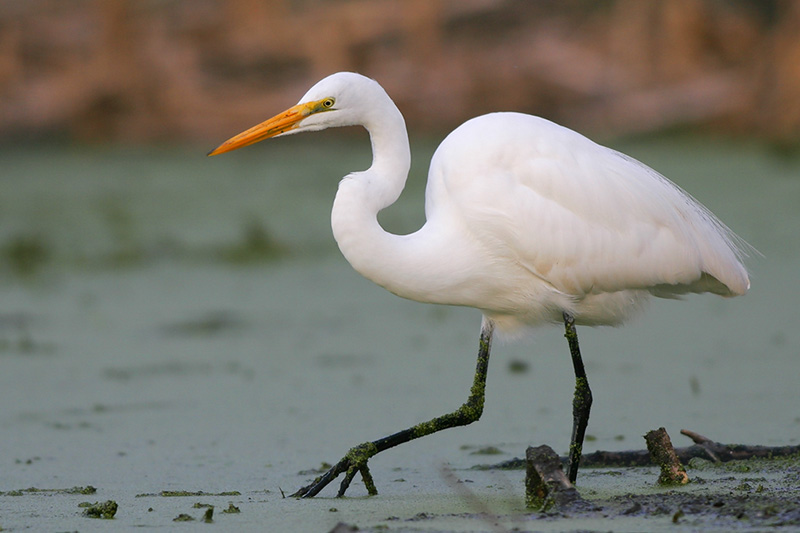
Scientific name: Ardea alba
Length: 39 inches
Weight: 1.9 pounds
Wingspan: 51 inches
Song: “koorr”
The Great Egret is a big, white heron with a long neck, and long dark legs and feet. Both sexes look similar and have long, sharp yellow beaks, and pale eyes.
In breeding season, they have long, elegant white plumes on their backs, and greenish skin in front of their eyes.
In flight, this large waterbird shows long, broad wings and a short, broad tail. Its legs trail out behind it and the bird holds its neck tucked in.
Great Egrets feed on fish, frogs, snakes, and other small animals that venture too close, birds and rodents included. They wade in or near water and then wait until prey comes close. If the animal approaches within range, they quickly catch it with their long, sharp beak.
It is common in wetlands in much of the USA, parts of southern Canada, and many other parts of the world.
Key Identifications:
- Big white bird with a long neck, yellow beak, and dark legs and feet.
- Feeds in and near wetlands, on the ground. Catches fish and small animals with its long, sharp beak.
- Makes bulky stick nests in colonies.
- Great Egrets make deep, croaking sounds, especially when taking flight. “koorr…koorr“
The Great Egret is a common and conspicuous bird of wetland habitats. It can be seen alone or in groups taking advantage of an easy food source. They use their long, sharp bills to catch a wide variety of animals.
This species is also the symbol of the Audubon Society. This organization was formed in 1905 to protect Great Egrets and other birds. At that time, in the USA, these large herons had been hunted to near extinction to supply elegant plumes for women’s hats.
Carolina Wren
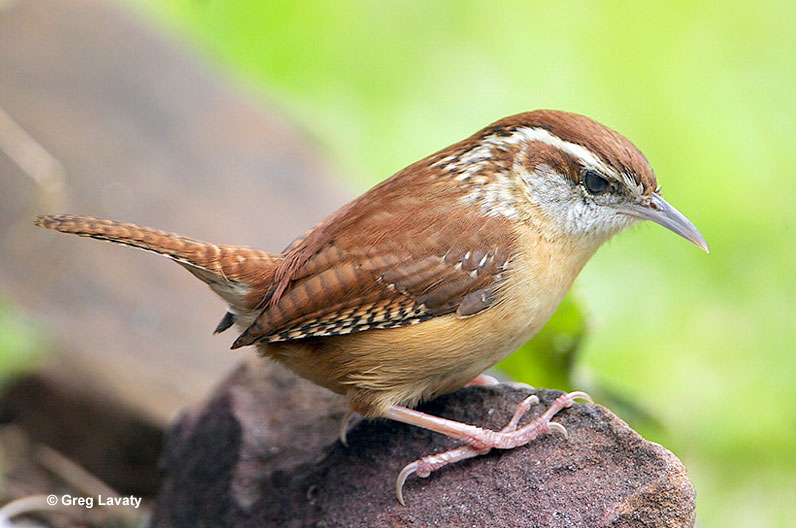
Scientific name: Thryothorus ludovicianus
Length: 5.5 inches
Weight: 0.74 ounces
Wingspan: 7.5 inches
Song: “teakettle, teakettle, teakettle”
The Carolina Wren is a small, reddish-brown and buff bird with a long, sharp, slightly decurved beak. It has a long, narrow, white eyebrow, a white throat, and some white mottling on its face. Males and females are similar and have black barring on their short wings, long tail, and under the tail.
Juveniles are similar but have paler underparts. This animated and vocal little bird forages for bugs in vine tangles and other dense vegetation. It usually occurs in pairs that can easily hide in the dense vegetation they prefer.
Carolina Wrens build a domed, cup nest made of sticks and soft vegetation. There is a side entrance and it can be placed in cavities and crevices of stumps, bushes, trees, potted plants, and other structures.
The Carolina Wren lives in vegetated gardens, second growth, parks and similar habitats in much of the eastern USA, parts of southern Ontario, and parts of eastern Mexico.
Key Identifications:
- Small reddish-brown and buff bird with a long beak and long white eyebrow.
- Feeds on arthropods in dense, tangled vegetation.
- Makes a domed cup nest with a side entrance in crevices, tree cavities, and human-made structures.
- Carolina Wrens fill the garden with loud and melodious songs. One common song sounds like, “teakettle, teakettle, teakettle“. They also make trilled sounds and harsh, nasal calls.
The Carolina Wren is a vocal species of gardens and second growth. Pairs use their long beaks to catch bugs and insects and aren’t shy about nesting near people. Many of these friendly birds have nested in such places as old shoes, potted plants, and abandoned cars.
Fish Crow
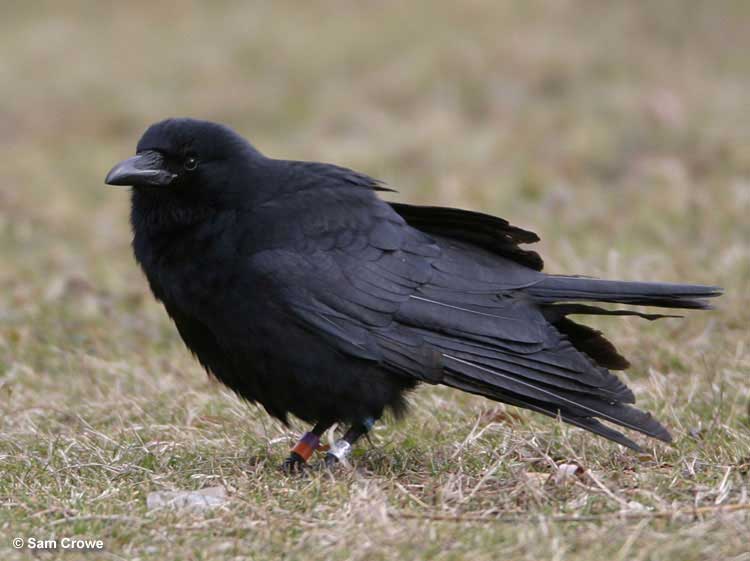
Scientific name: Corvus ossifragus
Length: 15 inches
Weight: 10 ounces
Wingspan: 36 inches
Song: “cuh”
The Fish Crow is a large, all black bird with a stout, black beak. Both males and females look the same and have some feathers on top of their bill, long wings, and a broad tail. In certain lighting, they also show some dark blue and purple highlights.
This species feeds on small creatures and a wide variety of food items found in coastal habitats and in other wetlands. It also scavenges for carrion and preys on eggs and nestlings of other bird species.
In particular, Fish Crows are important predators at nesting colonies of waterbirds.
After breeding, Fish Crows form large flocks and, in many places, they have become adapted to living in urban areas. These birds have become used to people but don’t usually visit feeders.
They build large, messy stick nests high in trees, and only live in coastal areas and wetlands in the eastern USA.
Key Identifications:
- Large black bird with long wings and a broad tail.
- Feeds on carrion, small animals, and many other food items.
- Makes messy stick nests in trees.
- Fish Crows are vocal, social birds. Their nasal call is the best way to separate them from the American Crow. It sounds like, “cuh, cuh“.
The Fish Crow is a common and conspicuous bird in coastal areas and near rivers and lakes. This omnivorous bird feeds on a variety of items and can form large flocks in fall and winter. Although Fish Crows were historically restricted to shorelines and coastal marshes, they have become adapted to living with people and are expanding their range.
Osprey
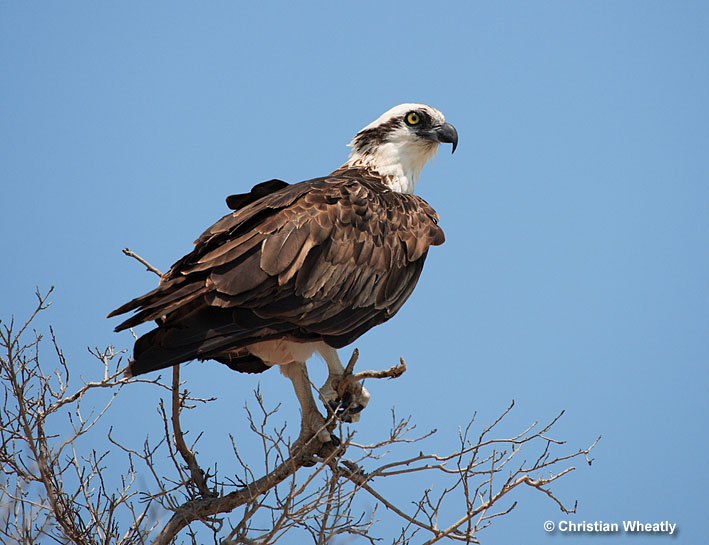
Scientific name: Pandion haliaetus
Length: 23 inches
Weight: 3.5 pounds
Wingspan: 63 inches
Song: “churp! churp! tewee tewee”
The Osprey is a large, pale raptor with long wings. It has a dark brown narrow mask, pale eyes, and a short crest.
Male and female Ospreys look alike and are dark brown above and white below with dark brown bands on their broad tail. They also have dark brown mottling on their underwings, and have a blue-gray, hooked beak.
Ospreys feed entirely on fish. They catch them by flying over water, and then soaring and hovering while looking down into the water. When they see a fish near the surface, they plunge down and snatch the fish with their long, sharp talons.
The Osprey then carries the fish to a tree to feed on it. This large bird builds big bulky, stick nests in trees and on platforms near waterways.
It lives along shorelines, in marshes, and on rivers and lakes in Canada, and many parts of the northern, western, and southeastern USA. They are common birds of Florida.
Key Identifications:
- Large pale raptor with long wings and a dark mask. It is dark above and white below.
- Feeds on fish caught in lakes, rivers, and along seashores.
- Makes bulky stick nests in trees and on platforms in wetlands.
- Ospreys are vocal birds and often call in flight. They make short, whistled calls that sound like, “churp! churp! tewee tewee”.
The Osprey is a common sight in coastal areas and around lakes, rivers, and other wetlands. They are often seen in flight as they hover above water to hunt for fish. During the 50s and 60s, the pesticide DDT caused large declines in Osprey numbers. Fortunately, since those years, they have recovered in most parts of their range.
Turkey Vulture
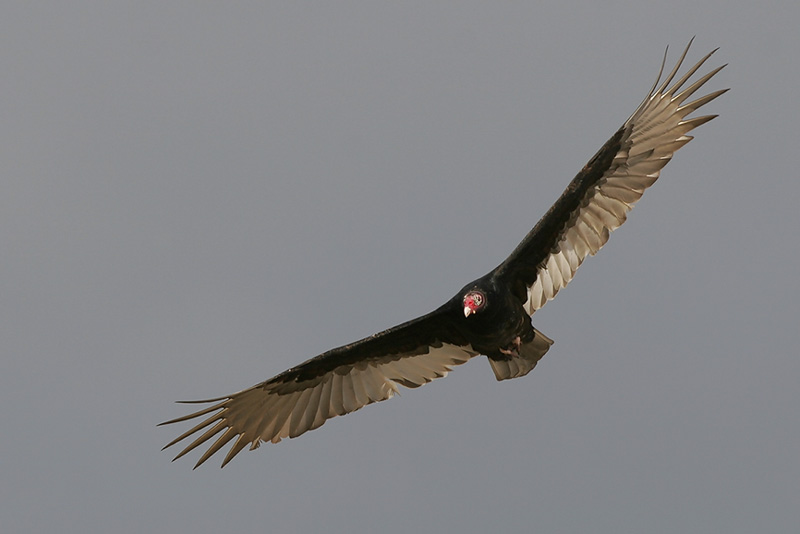
Scientific name: Cathartes aura
Length: 26 inches
Weight: 4 pounds
Wingspan: 67 inches
Song: “hisss”
The Turkey Vulture is a big, dark brownish-black raptor with a small red head and long, broad wings. Males and females look alike and also have a longish tail.
In flight, the way Turkey Vultures soar is one of the best ways to recognize them. They fly with their wings held in a “V” shape and, when gliding, often rock back and forth.
Their flight feathers are also paler than the rest of their wings but they lack the Black Vulture’s white wing patch.
Turkey Vultures are scavengers and most of their diet is carrion. They eat road kill and a wide variety of dead animals. This species forages over every type of habitat and can also fly over urban areas.
It lays two eggs on the ground in caves and hollow logs.
Turkey Vultures live in Florida year-round, but some birds fly to northern areas for the breeding season.
Key Identifications:
- Big, dark raptor with a small red head that soars with long wings held in a “V”.
- Feeds on dead animals.
- Nests on the ground in caves and hollow logs in secluded areas.
- Turkey Vultures rarely call and mostly make hissing sounds at their nest.
The Turkey Vulture is commonly seen flying over every type of habitat. They are often seen on their own but can occur in flocks, especially during migration. Unlike most other birds, this species uses its amazing sense of smell to find dead animals.
Blue-gray Gnatcatcher
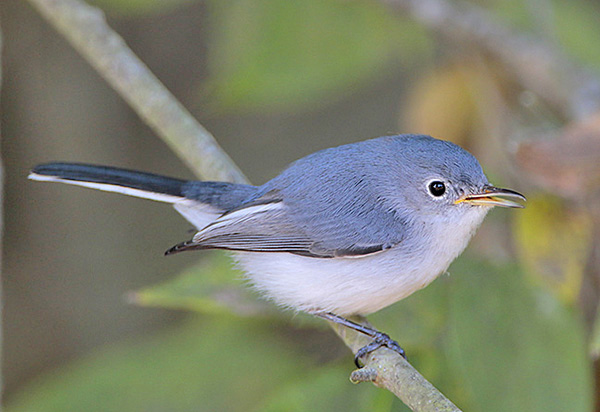
Blue-gray Gnatcatcher is one of the most common birds of Florida. Photograph © Greg Lavaty.
Scientific name: Polioptila caerulea
Length: 4.5 inches
Weight: 0.21 ounces
Wingspan: 6 inches
Song: “nheah, sip, nheah”
The Blue-gray Gnatcatcher is a tiny, pale gray and white bird with a slender beak. They are blue-gray above and pale gray below with a white eyering. They also have some white edging in their short wings and a longish, black and white tail.
Both sexes look similar except that males have a small black line above their eyes. This species feeds on small insects that it catches in bushes and deciduous trees.
It forages by quickly moving through vegetation and picking bugs from vegetation. They can also fly out to catch insects in flight.
Blue-gray Gnatcatchers make a small cup nest out of lichens and spider webs, usually high in a tree. They live in hardwood forests and are year-round residents in most parts of Florida, but live in southern areas only during the winter months.
Key Identifications:
- Tiny pale blue-gray and white bird with a slender beak and longish black and white tail.
- Actively forages for insects.
- Makes a small pale cup nest high in trees.
- Blue-gray Gnatcatchers are quite vocal and make nagging nasal calls. Their most common call sounds like, “nheah, sip, nheah”. They also sing a scratchy song with nasal and tinkling sounds.
The Blue-gray Gnatcatcher lives in hardwood forest habitats. Their nasal calls often reveal their presence as they forage in bushes and high overhead. The nests of these “mini mockingbirds” are so small and camouflaged, they look just like a pale lump on a branch.
Red-shouldered Hawk
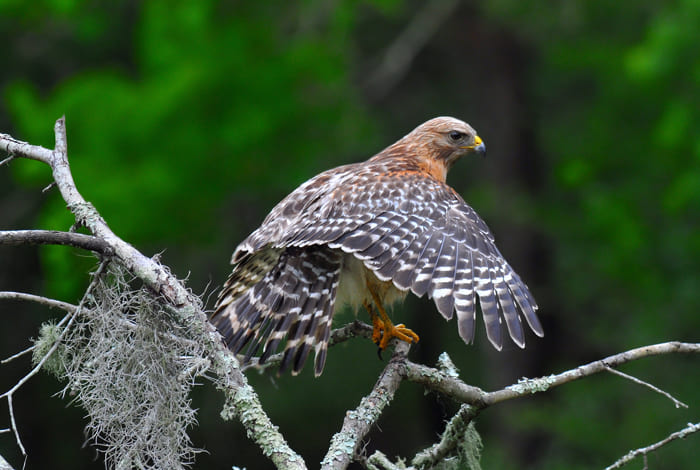
Scientific name: Buteo lineatus
Length: 17 inches
Weight: 1.4 pounds
Wingspan: 40 inches
Song: “Kyeah, Kyeah, Kyeah, Kyeah!”
The Red-shouldered Hawk is a medium-sized raptor with a black and white tail. This crow-sized hawk is dark brown and reddish above and has reddish-orange underparts.
Males and females look alike but females are larger. This hawk also has a dark mark on each side of its throat, and black and white wings with a red shoulder. Juveniles resemble adults but are brown with dark brown streaks below.
In flight, Red-shouldered Hawks have long, broad wings with a pale, crescent-shaped mark on the base of their primaries.
These raptors feed on small animals including frogs, snakes, squirrels, and occasional birds. They hunt by watching from a perch and them swooping down to catch the animal on the ground.
Red-shouldered Hawks build a bulky stick nest high in a tree and live in hardwood forest habitats. We find them in southeastern Canada, the eastern USA, and from southern coastal Oregon south to Baja California.
Key Identifications:
- Crow-sized, colorful raptor with reddish-orange below and black and white wings and tail.
- Preys on snakes, frogs, and other small animals.
- Builds a bulky nest high in a tree.
- Red-shouldered Hawks are vocal raptors that make loud, jay-like, or even gull-like calls. They often make a repeated sound, “Kyeah, Kyeah, Kyeah, Kyeah!“, and can also make shorter “Kiyip! Kiyip!” calls.
The Red-shouldered Hawk lives in hardwood forest and other woodlands. In some areas, it is an urban bird and one of the most common raptors. Red-shouldered Hawks can join American Crows to chase Great-Horned Owls away from their territories.
Read Also: Hawks in Florida
Great Blue Heron
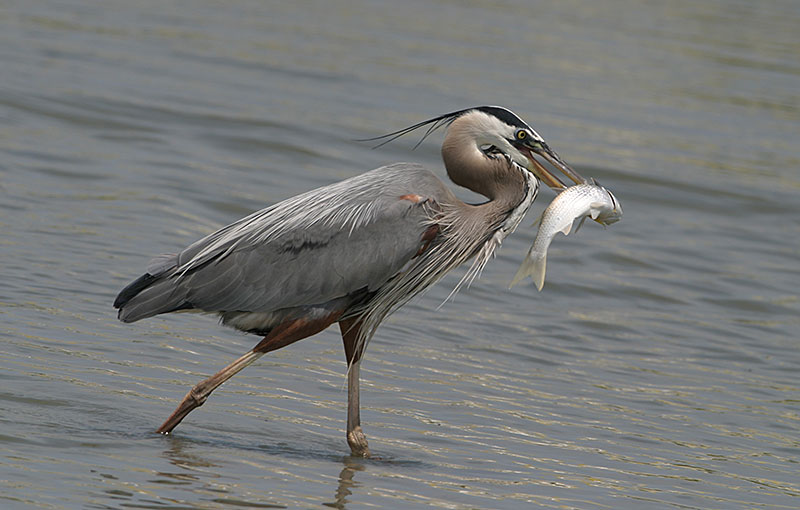
Great Blue Heron is a common bird in Florida
Scientific name: Ardea herodias
Length: 46 inches
Weight: 5.3 pounds
Wingspan: 72 inches
Song: “Grunk! Grunk!”
The Great Blue Heron is a large, gray and pale brown heron with a long neck and legs. It has a strong, yellowish beak, black and white head with a wispy black crest, and rufous thighs.
Both sexes are alike and have pale bellies and black flanks. Juveniles have streaked underparts.
In flight, they make slow, deep flaps with long, broad gray and black wings. In Southern Florida and the Caribbean, Great Blue Herons are all white and sometimes considered a separate species, the “Great White Heron”.
These powerful herons feed on fish and small animals such as rats, snakes, and birds. They wade in and near water, wait, and then quickly catch prey with their sharp beaks.
Great Blue Herons build messy, stick nests and breed in colonies, often in swamps.
They are common birds in Florida and love the shallow waters.
Key Identifications:
- Huge gray and pale brown wading bird with a thick, yellowish beak and a wispy crest. In southern Florida, it is all white but still has a crest and a strong yellowish beak.
- Stalks and preys on fish and small animals.
- Builds messy stick nests and breeds in colonies.
- Great Blue Herons aren’t all that vocal. When taking flight they make a croaking sound, “Grunk! Grunk!“.
The Great Blue Heron occurs on rivers, lakes, and many other wetlands. It stands still for long periods of time while waiting for prey to come within range of its sharp beak but is also, often seen in flight.
Palm Warbler
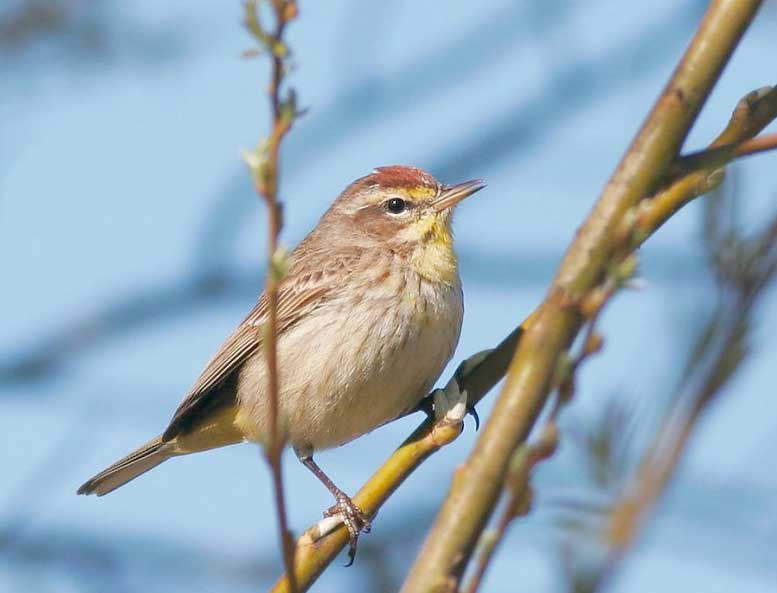
Scientific name: Setophaga palmarum
Length: 5.5 inches
Weight: 0.36 ounces
Wingspan: 8 inches
Song: “zipzipzipzipzipzipzipzipzip”
The Palm Warbler is a small bird with a rufous cap, yellow eyebrow and yellow throat. Males and females look alike, are grayish-brown above, have a yellowish rump, and yellow under their tail.
They also have gray-brown on their face, a dark slender beak, and fine streaks below. Some birds are all yellow below and others only have yellow on the face and under the tail.
In winter, they are duller but always have yellow under the tail.
These warbles feed on small insects. They aren’t shy and constantly bob their tail up and down as they pick bugs from low vegetation, lawns, and open ground.
They breed in boreal bogs in Canada and parts of the northern USA, but spend their winters in Florida.
Key Identifications:
- Small and slender bird with a rufous cap, grayish-brown face, pale eyebrow, and yellow under the tail. They are also plain, gray-brown above, and have fine streaks on yellow or pale underparts. They also constantly wag their tail up and down.
- Picks small insects from low vegetation and the ground.
- Builds soft cup nest on the ground beneath small conifers in boreal bogs.
- Palm Warblers have a trilled song, “zipzipzipzipzipzipzipzipzip”. They sing in spring and also make a sharp chip call.
The Palm Warbler breeds in northern bogs but winters in parks and other semi-open habitats. This tame bird spends most of its time in low vegetation and on the ground. Palm Warblers winter around palm trees but don’t breed in them.
Boat-tailed Grackle
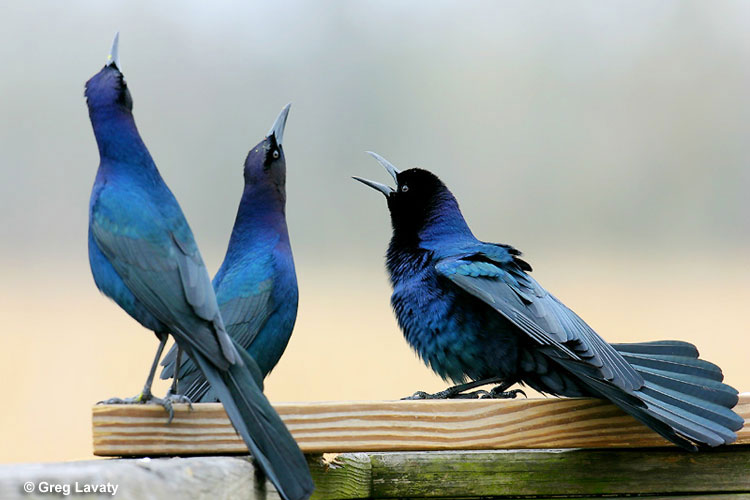
Boat-tailed Grackles
Scientific name: Quiscalus major
Length: 14.5-16.5 inches
Weight: 4.2-8 ounces
Wingspan: 17.5-23 inches
Song: “zeet zeet zeet purr, purr, purr”
The Boat-tailed Grackle is a large blackbird with a hefty black beak, brown eye, and long, dark tail. Males are glossy black with purple and deep blue iridescence. They have a long, wedge-shaped tail and longish, black legs and feet.
Females are shaped like males but are smaller, tawny-brown with dark wings and tail, have a shorter tail, and a dark face.
This big grackle forages on the ground in marshes, wetlands, and other open habitats. These birds occur in flocks where they walk along and pick up insects, seeds, and small aquatic creatures with their beaks.
Boat-tailed Grackles breed in colonies and build cup nests made of grass and other bits of vegetation. They are in bushes and trees near and above water.
The Boat-tailed Grackle lives in marshes in coastal areas of the southeastern USA. As one of the most common birds of Florida, this bird has become used to people and also occurs near inland wetlands and urban areas.
Key Identifications:
- Big blackbird with dark eyes and a long, wedge-shaped tail.
- Picks insects, seeds, and aquatic creatures from the ground of marshes and other open habitats.
- Breeds in colonies and has a cup nest made of grasses and other vegetation.
- Boat-tailed Grackles make a variety of loud trilled and piping calls, “zeet zeet zeet purr, purr, purr“.
The Boat-tailed Grackle is a big blackbird that occurs in flocks in coastal wetlands. In Florida, it also lives in urban areas and near freshwater lakes and rivers. If a young Boat-tailed Grackle falls into the water, it uses its wings to swim to safety.
Tufted Titmouse
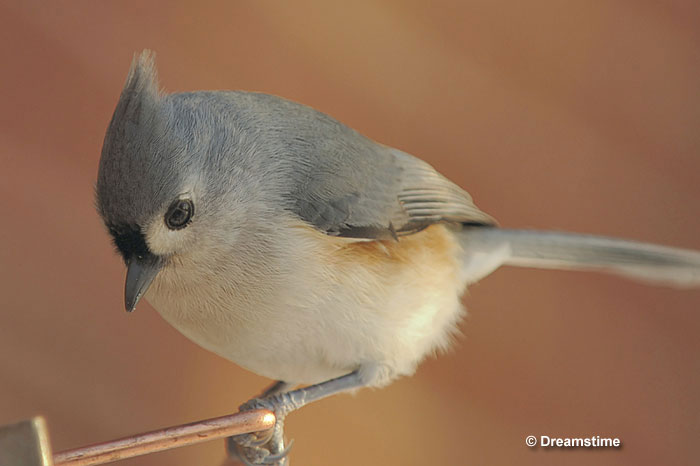
Scientific name: Baeolophus bicolor
Length: 6.5 inches
Weight: 0.75 ounces
Wingspan: 9.75 inches
Song: “peter peter peter”
The Tufted Titmouse is a small, crested, blue-gray bird with a white face. Males and females look the same and have a small black mark above their stubby black beak. They also have pale underparts with peach-orange flanks.
These cute little birds occur in small groups that forage for insects and seeds in parks and woodlands. They move through the trees and use their bills to pick food from leaves, bark, and branches. Tufted Titmouse are also regular visitors to bird feeders.
These small birds nest in woodpecker holes and other cavities in dead trees, and can also use nest boxes.
We find the Tufted Titmouse in hardwood forests and forested urban areas. They are often heard before they are seen, and flock with other small birds. When they see a predator, they are some of the first birds to harass it.
The Tufted Titmouse occurs in the eastern USA and some parts of southeastern Canada.
Key Identifications:
- Small, crested blue-gray bird with pale underparts and a white face.
- Feeds on seeds and insects and visits feeders.
- Nests in tree cavities and nest boxes.
- The Tufted Titmouse is a very vocal bird. It gives constant whistled calls over and over, “peter peter peter“.
The Tufted Titmouse is an easily recognized bird that lives in parks, gardens, and woodlands. It occurs in small flocks, often visits feeders, and needs dead trees or nest boxes to breed. This species lines its nest with mammal hair including fur from Raccoons, Opossums, and other animals.
Anhinga
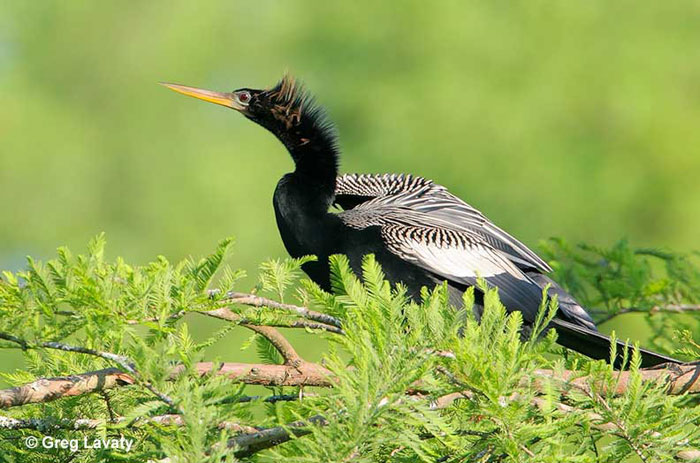
Scientific name: Anhinga anhinga
Length: 35 inches
Weight: 2.7 pounds
Wingspan: 48 inches
Song: “grrr, grrr, grrr, grrr”
The Anhinga is a large, dark bird with silver highlights in its wings and back, a long neck, and a sharp, yellowish beak. It also has a long, rectangular tail with dark barring and a buff tip.
Males have a black neck and females have a tawny head, neck, and breast. Both sexes have webbed feet and a small greenish patch around their eyes.
These aquatic birds often soar above wetlands on long, broad wings. While soaring, they hold their necks out and look sort of like a flying “cross”.
Anhingas forage underwater for fish. They catch them by swimming underwater and stabbing the fish with their sharp beaks. After catching food, they climb onto a perch to eat it and dry out their wings.
The Anhinga builds a bulky platform nest in trees and bushes over water. It usually nests in colonies with other waterbirds.
Anhingas frequent wetland habitats in the southeastern USA south to northern Argentina. Anhingas are common birds of Florida.
Key Identifications:
- Large dark waterbird with a long neck and long, sharp beak. Females have a tawny head and neck.
- Swims underwater to catch fish with its sharp bill.
- Builds a bulky stick nest and breeds in colonies.
- The Anhinga makes low, guttural calls when perched. They sound like, “grrr, grrr, grrr, grrr“.
Anhingas are large, dark birds with slender necks and beaks. They are highly aquatic and live in a variety of wetlands. The Anhinga has also been known as the “snakebird” and the “water turkey”.
Downy Woodpecker
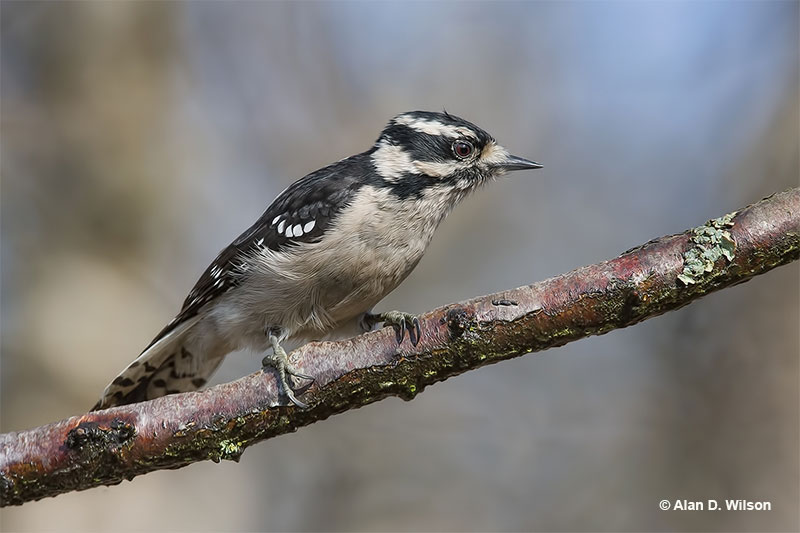
© Alan D. Wilson
Scientific name: Dryobates pubescens
Length: 6.75 inches
Weight: 0.95 ounces
Wingspan: 12 inches
Song: “Pik! Ch,ch,ch,ch,ch,ch,ch!”
The Downy Woodpecker is a small black and white woodpecker with a short, black beak. They are patterned black and white above and have white backs and white underparts. Both sexes look alike except that males have a small, bright red patch on the top back part of their head.
Young birds look like adults but have a reddish patch on the top of their head. Downy Woodpeckers also have a few small black marks in their white outer tail feathers, and a small white tuft at the base of their beak.
This woodpecker eats insects, other small creatures, seeds, and small fruits. It pecks into live and dead wood and often forages on smaller branches and twigs. These friendly little woodpeckers are also common feeder birds.
They nest in tree cavities and live in gardens and a wide variety of woodlands. We see Downy Woodpeckers in much of Canada and the USA but not in arid habitats. They arecommon birds of Florida.
Key Identifications:
- Smallest woodpecker in North America. Mostly black and white with a short, black beak.
- Forages on trees, in bushes, and at feeders for insects, seeds, and suet.
- Nests in tree cavities.
- The Downy Woodpecker makes sharp “pik!” calls and also has a trilled call, “Ch,ch,ch,ch,ch,ch,ch!“.
Downy Woodpeckers are the smallest woodpecker species in North America and usually occur in pairs. They can also forage with other small birds and often visit feeders. This species takes advantage of its size to peck into the stems of weeds and other plants too small for larger woodpeckers to perch on.
Little Blue Heron
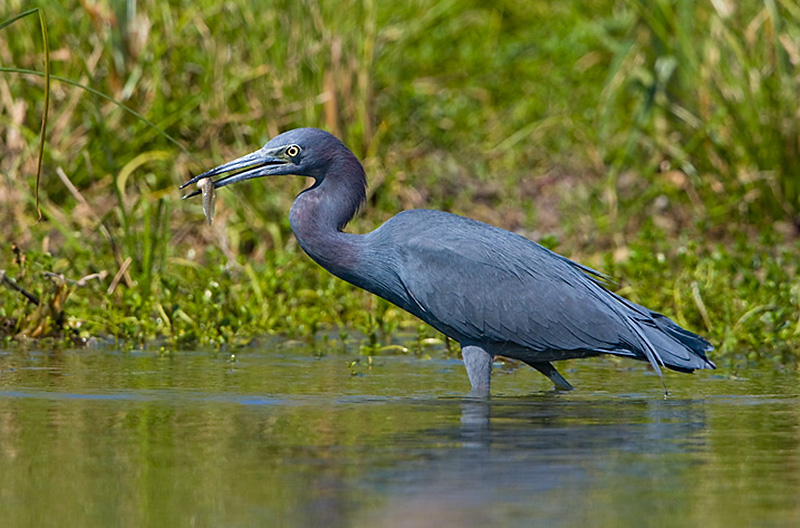
Copyright Glenn Bartley
Scientific name: Egretta caerulea
Length: 24 inches
Weight: 13 ounces
Wingspan: 36 inches
Song: “Greah, Greah, Greah, Greah!”
The Little Blue Heron is a smallish heron species that has a long, sharp gray beak with a dark tip. Adults are dark, slate, blue-gray with a dark maroon neck and head, and long, gray-green legs and feet.
Young birds have beaks and legs like the adults but are mostly white or white with patches of slate, blue-gray.
In flight, Little Blue Herons usually tuck their necks in and show long, broad wings and a short broad tail.
Related: Do Mallards live in Florida?
This heron species feeds on fish and other small animals. It wades or waits near water and quickly strikes with its beak when prey comes close. Little Blue Herons nest in colonies over water and build a bulky stick nest in a low tree or bush.
This species lives in a variety of wetland habitats from Nebraska, Ohio, and coastal Massachusetts south to Florida and South America. Some birds migrate to California, Mexico, and Central America.
Key Identifications:
- Smallish, elegant, all dark heron or white with a bicolored grayish and black beak and greenish legs.
- Catches fish and small animals in a variety of wetland habitats.
- Constructs a bulky stick nest in colonies with other waterbirds.
- The Little Blue Heron is usually quiet but makes guttural, rasping calls when taking flight, “Greah, Greah, Greah, Greah!“.
Little Blue Herons are small, common herons of coastal marshes, rivers, lakes, and other wetlands. They stalk fish and small animals at the edge of the water, and nest in colonies. This bird uses a comb-like structure on its toe to fix its feathers and scratch itself.
Common Grackle
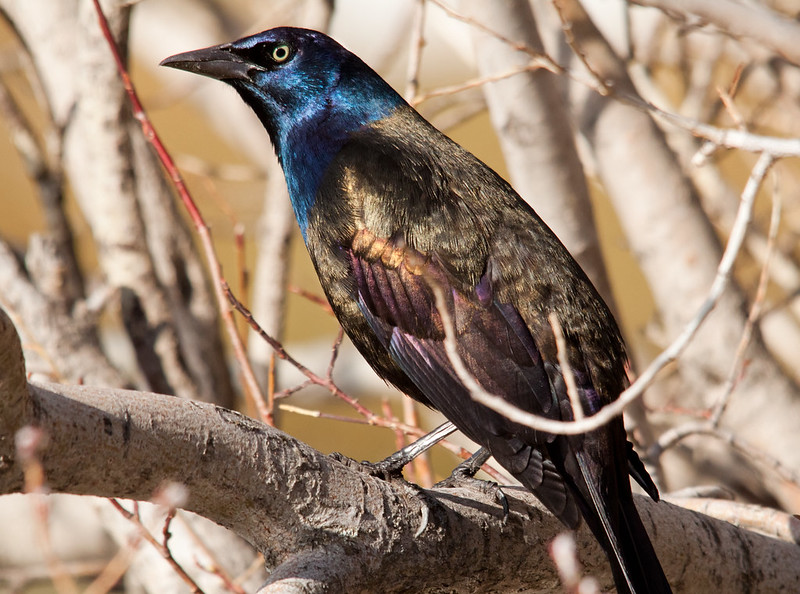
© Shawn McCready
Scientific name: Quiscalus quiscula
Length: 12.5 inches
Weight: 4 ounces
Wingspan: 17 inches
Song: “Sherink!”
The Common Grackle is a jay-sized, glossy black bird with pale eyes and a long, wedge-shaped tail. Depending on lighting, this bird shows metallic purple, blue, green, and bronze highlights.
Males and females look very similar but females have shorter tails and less iridescence. Both sexes also have stout, black beaks, and strong, black legs and feet.
In flight, Common Grackles move up and down as they move through the air. They usually flock together and often forage in farm fields, on lawns, and in other open habitats. These omnivores feed on a variety of items including insects, seeds, grain, small animals, garbage, and the eggs and nestlings of other birds.
Common Grackles build bulky stick nests, usually in conifers in woodlands, parks, near water, and urban areas.
This species can form big flocks in the winter and lives in a variety of semi-open and open habitats in eastern Canada and the eastern USA.
Key Identifications:
- Fairly large, black bird with glossy purple, greenish, bronze, or dark blue highlights. It also has pale eyes and a long, wedge-shaped tail.
- Forages for insects, seeds, and other food on the ground in a variety of open habitats.
- Constructs a bulky cup nest in a conifer.
- Common Grackles are vocal birds. They frequently give raspy, metallic calls, “Sherink!”, and “kek” calls.
The Common Grackle is a common, glossy black bird with pale eyes. It usually occurs in flocks in open and park-like habitats. This species occasionally nests in odd places, including occupied nests of Great Blue Herons and Ospreys!
American Crow

© Alan D. Wilson
Scientific name: Corvus brachyrhynchos
Length: 17.5 inches
Weight: 1 pound
Wingspan: 39 inches
Song: “Caw! Caw!”
The American Crow is a big, all black bird with a strong, stout bill. In certain lighting, it can have metallic purple and blue iridescence.
Both sexes look the same and have some feathering on their beaks, long, broad wings, and a broad tail.
American Crows have direct flight with strong, steady wing beats. Crows are very social and intelligent birds that are usually seen in flocks. They forage together on the ground or in trees and eat just about anything they can find.
Some of their more regular foods include carrion, fruit, nuts, seeds, insects, and small animals. Like most jays and crow species, they also eat the eggs and nestlings of other bird species.
This species builds bulky stick nests high in trees and lives in most habitats except for high mountains and arid zones.
The American Crow occurs in southern Alaska and much of Canada and the USA. American Crows are common birds of Florida.
Key Identifications:
- Big, all black bird with long, broad wing and a broad tail.
- Forages for carrion, fruit, seeds, insects, and small animals.
- Builds a bulky stick nest high in a tree.
- American Crows are very vocal birds. They can make several calls but their most common one is, “Caw! Caw! Caw!”.
The American Crow is a common, large black bird that frequently calls, “Caw! Caw! Caw!”. It usually occurs in flocks and lives in all sorts of places, even urban zones. These birds are very smart and have funerals or wakes! When a crow dies, other crows mark the occasion by gathering together and loudly calling.
Red-winged Blackbird
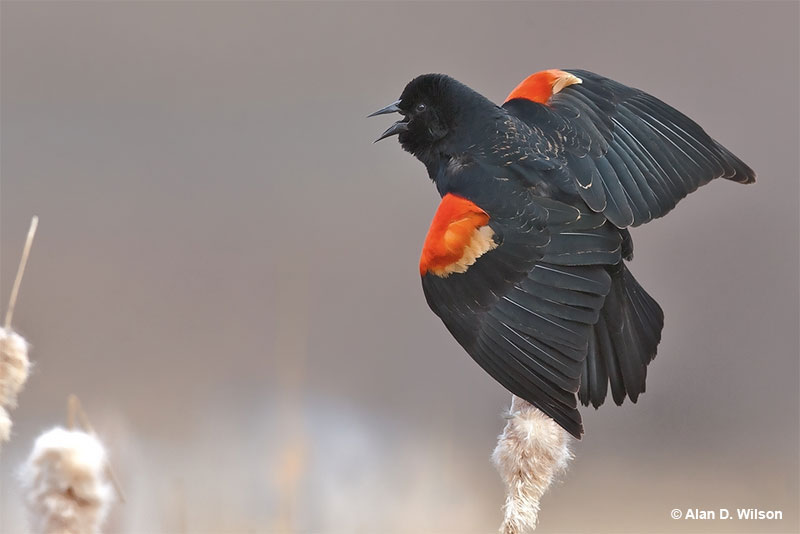
Scientific name: Agelaius phoeniceus
Length: 8.75 inches
Weight: 1.8 ounces
Wingspan: 13 inches
Song: “kan-keree!”
The Red-winged Blackbird is a medium-sized blackbird species with a sharp, all black bill. Males also have a scarlet patch with a pale yellow border on the shoulder of each wing.
Female Red-winged Blackbirds are dark, heavily streaked, brownish-gray birds with an orange-buff eyebrow and throat. She can also have a little bit of dingy red on her shoulder.
Red-winged Blackbirds often flock together and can form very large groups in the winter. They feed on seeds, grain, and insects found on lawns, in marshes, farm fields, and other open habitats.
This species builds a cup nest made of leaves and dead stems in a bush or other low vegetation in a marsh, park, or brushy field.
Red-winged Blackbirds are very common birds that live in all sorts of open habitats. We see them in parks, farming areas, and marshes in much of Canada, the USA, Mexico, and parts of the Central America.
Key Identifications:
- Males are medium-sized blackbirds with a bright red patch on their wings. Females are heavily streaked, have a sharp black beak, and buff on the head.
- Feeds on seeds, grain, and insects on the ground in many open habitats.
- Builds a cup nest in a bush or other low vegetation.
- Red-winged Blackbirds often call. Males sing a loud, “kan-keree!” and both sexes also make “check!” calls and a high-pitched whistle-like sound.
The Red-winged Blackbird is a common, social species easily seen in marshes and open habitats. In the winter, it can form huge flocks that feed in farm fields. This species can make a daily commute of 50 miles to and from roosting and feeding sites.
Double-crested Cormorant
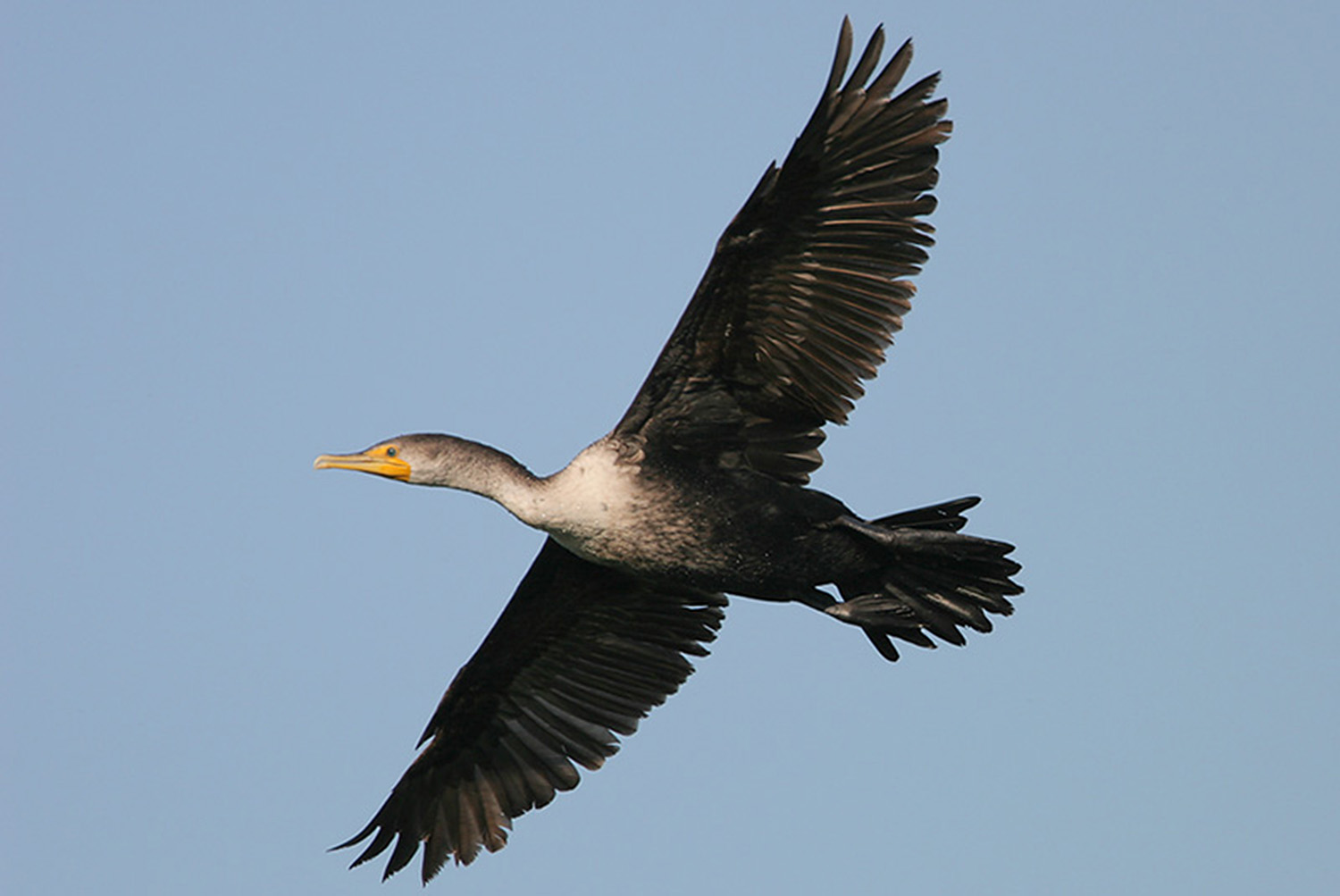
Photograph © Greg Lavaty.
Scientific name: Nannopterum auritum
Length: 33 inches
Weight: 3.7 pounds
Wingspan: 52 inches
Song: “groak”
The Double-crested Cormorant is a big, glossy black bird with a long, thick neck. Males and females look alike and also have a medium-length beak with a sharp, hooked tip, an orange throat patch, and a bit of orange on the face.
Double-crested Cormorants have a short, wispy crest, green eyes, broad tail, and big webbed feet. They use their long wings to flap and glide with direct flight between feeding and roosting areas.
This highly aquatic species feeds on fish. It catches its food by diving, swimming beneath the water and then snatching a fish with its beak. It eats the fish while perched above the water.
We see this bird in parts of central and southern Canada, in much of the USA, and parts of Mexico and the Caribbean. They are common birds of Florida year-round.
Key Identifications:
- Big, nearly goose-sized black bird with a long, thick neck, and a medium-length narrow beak with a small, hooked tip. It also has a rectangular, orange throat patch.
- Forages by floating and then diving beneath the water. Swims underwater to catch fish with its beak.
- Breeds in colonies and constructs a messy stick nest in trees on islands, or over water.
- Double-crested Cormorants aren’t very vocal. They make some low, guttural, pig-like sounds at their breeding colonies, “groak”.
It often occurs in flocks that frequent lakes, rivers, and other wetlands. When it comes to fish, this species is not a picky eater; it has been documented eating more than 250 species.
Snowy Egret
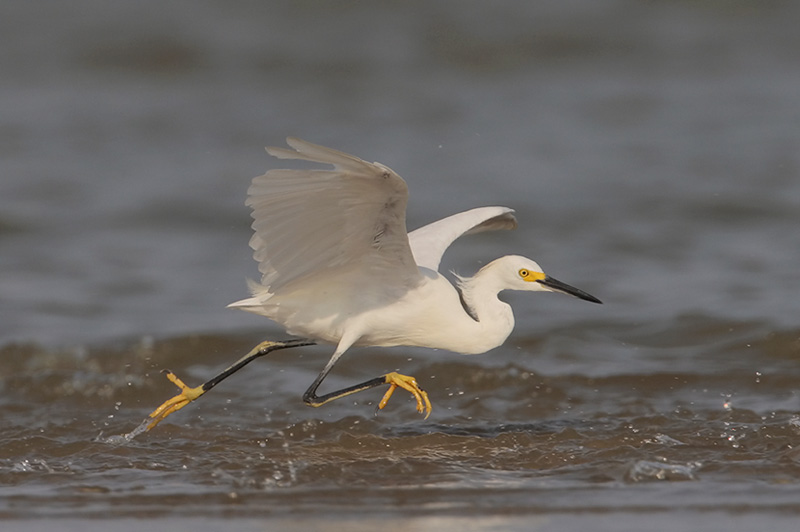
Scientific name: Egretta thula
Length: 39 inches
Weight: 1.9 pounds
Wingspan: 51 inches
Song: “rahh”
The Snowy Egret is a medium to large, elegant white bird with a long, slender black bill, and long black legs with yellow feet. Both sexes look alike and have some yellow skin in front of yellow eyes, a wispy white crest, and elegant plumes on their breast and lower back.
Snowy Egrets fly with long, broad wings, hold their necks tucked in, and have slow, deep wing beats.
This beautiful heron feeds on small fish, insects, and other small aquatic creatures. It catches food by wading in or near water, waiting until prey comes close, and quickly striking out with its long bill. In shallow water, it also briefly runs after small fish to catch them.
Snowy Egrets breed in colonies and make messy stick nests in trees and bushes. They live in coastal areas and along marshes, lakes, and rivers in much of the USA and Central and South America.
Key Identifications:
- Medium-sized elegant white heron with a long, black beak, and long black legs with yellow feet.
- Forages for small fish and other creatures by wading in or near shallow water and quickly snatching them with its beak.
- Breeds in colonies and makes a messy stick nest in trees and bushes, usually on islands or over water.
- Snowy Egrets are not very vocal birds. They usually make a croaking call when taking flight. It sounds like, “rahh”.
The Snowy Egret is a medium-sized, elegant white heron with a wispy crest, and “golden slippers”. It lives in coastal areas, marshes, and near lakes and rivers. Snowy Egrets catch prey in a number of ways including using one of their feet to stir up mud and flush food into the open.
Black Vulture
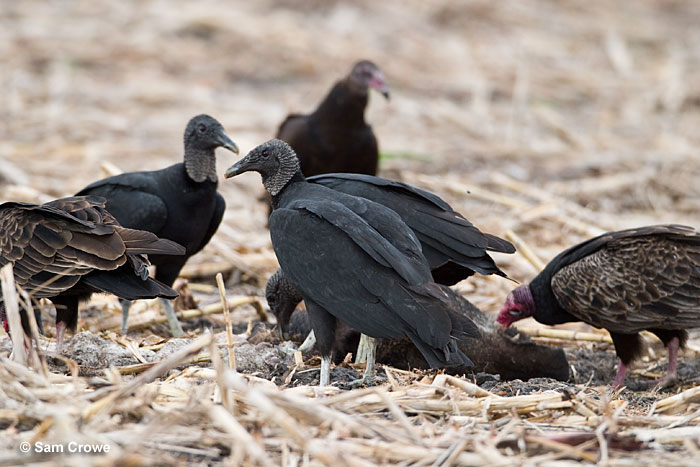
Scientific name: Coragyps atratus
Length: 25 inches
Weight: 4.4 pounds
Wingspan: 59 inches
Song: “whuf”
The Black Vulture is a big, bulky, black raptor with a naked, wrinkled black head and rather short, broad tail. It has a white patch near the tip of each of its long, broad wings, and a pale, slender beak with a hooked tip.
Male and female Black Vultures look alike and also have fairly long, blackish legs and feet. They fly with a few quick flaps followed by soaring with their wings held flat.
This species mostly feeds on carrion but it can also catch small animals when the opportunity presents itself. Black Vultures usually feed in flocks and find their food by soaring high overhead and watching for dead animals as well as following other vultures to food sources.
The Black Vulture lays eggs on the ground inside caves, abandoned buildings, hollow logs, or other dark and protected places. It uses a wide variety of habitats from southern New York west to Arizona and south to Argentina.
Key Identifications:
- Big, bulky black raptor with a black head, long, broad wings with a patch of white near the wingtip, and a short, broad tail.
- Feeds on freshly killed animals, and, occasionally, small animals.
- Lays eggs on the ground in caves, hollow logs, and other dark and protected places.
- Black Vultures are quiet birds. Once in a while, they make soft, muffled calls that sound like, “whuf”.
The Black Vulture is a large, mostly black raptor with broad wings and a short tail. Small groups often soar above wetlands, woodlands, residential areas, and other habitats. Surprisingly, their stomach acid is so strong, their droppings have little to no bacteria, viruses, or fungi.
Tricolored Heron
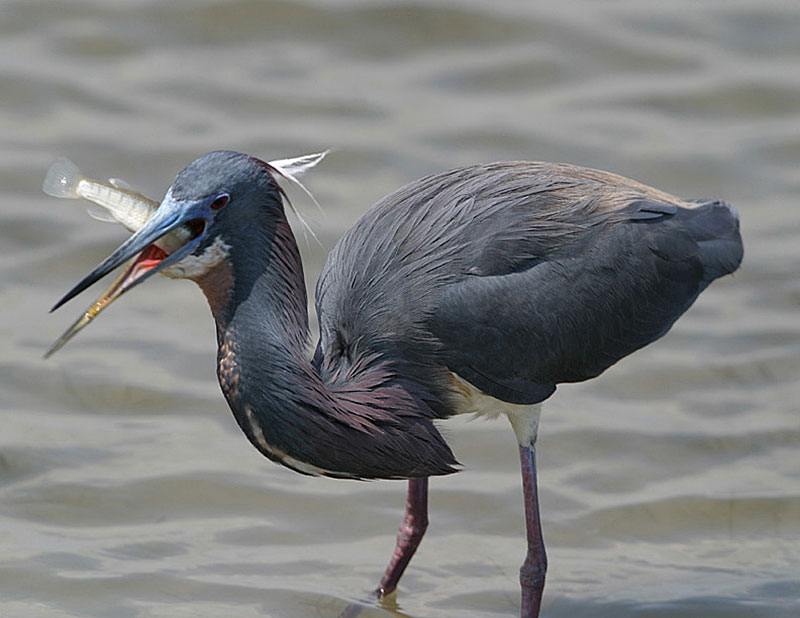
Tricolored Heron is one of the most common birds of Florida
Scientific name: Egretta tricolor
Length: 26 inches
Weight: 13 ounces
Wingspan: 36 inches
Song: “unh, unh”
The Tricolored Heron is a medium to large, elegant heron with a long beak, slate-gray upperparts, and a white belly. Both sexes are alike and have maroon highlights and white that extends from the throat down the front of the neck.
In breeding plumage, the skin in front of their eyes and part of their beak is bright blue. They also have a few white plumes on their head, and long pale plumes on their lower back.
In flight, it shows black and white on the underwing, tucks its neck in, and flies with slow, deep wing beats. Juveniles are more reddish-brown than gray.
Tricolored Herons mostly feed on small fish caught in shallow water. They breed in colonies, make messy stick nests, and live in coastal marshes and other wetlands. Tricolored Herons occur in coastal habitats of the eastern USA south to northern South America. In Florida, they also live away from the coast.
Key Identifications:
- Medium to large dark gray heron with a long beak and a contrasting white belly.
- Catches small fish with its long bill in shallow, coastal waters and marshes.
- Breeds in colonies and makes a messy stick nest.
- The Tricolored Heron is not very vocal but makes a nasal “unh, unh” sound when taking flight.
Tricolored Herons are fairly large, dark gray herons with a long beak and white belly. They usually forage alone as they hunt for small fish in shallow coastal waters and marshes. This species wades into deeper waters than other herons.
Gray Catbird
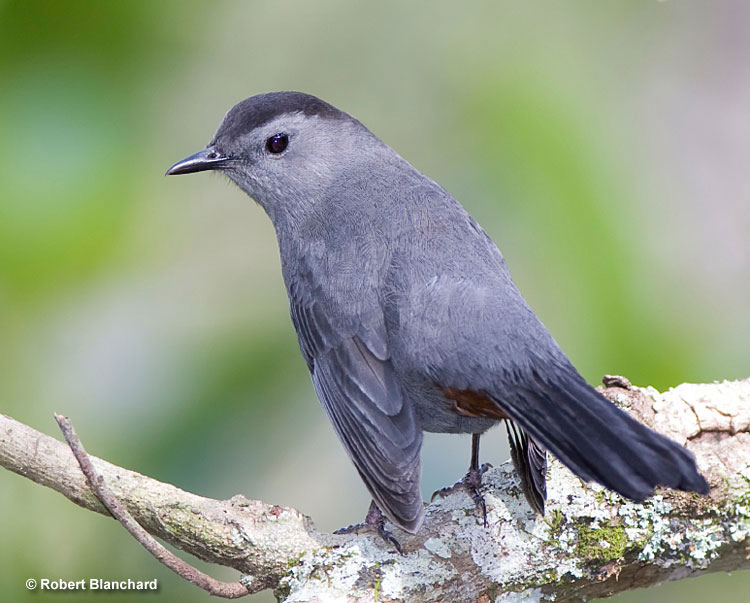
Scientific name: Dumatella carolinensis
Length: 8.5 inches
Weight: 1.3 ounces
Wingspan: 11 inches
Song: “rheah!”
The Gray Catbird is a slender, gray songbird with a black cap, and chestnut under its tail. Both sexes look alike and have beady, black eyes on a gray face, a longish tail, and a smallish, black beak.
This reclusive bird feeds on insects and berries in thickets and second growth. It forages by moving through dense vegetation and picking food items from leaves and twigs.
Gray Catbirds make bulky, open cup nests constructed with grass, strips of vegetation, and hair. They build their nests in shrubs, bushes, and small trees.
The Gray Catbird is often heard before it is seen, and loves to skulk in low thick vegetation. This migrant species spends summers in southern Canada, and in much of the eastern and northern USA. They can be seen in Florida during the non-breeding season.
Key Identifications:
- Small to medium-sized, slender gray bird with a black cap and chestnut under the tail.
- Feeds on insects and berries in low, dense vegetation.
- Builds a bulky cup nest in small trees and bushes.
- The Gray Catbird is quite vocal and often makes a cat-like mewing call, “rheah!”. It also has a melodious, complex song made of jumbled, chattering sounds and phrases.
Gray Catbirds are slender gray songbirds with a black cap and chestnut under the tail. Pairs forage for bugs and berries in dense second growth. Although they don’t mimic as many bird species as their mockingbird relatives, Gray Catbird songs include the sounds of some birds, frogs, and other noises.
Laughing Gull
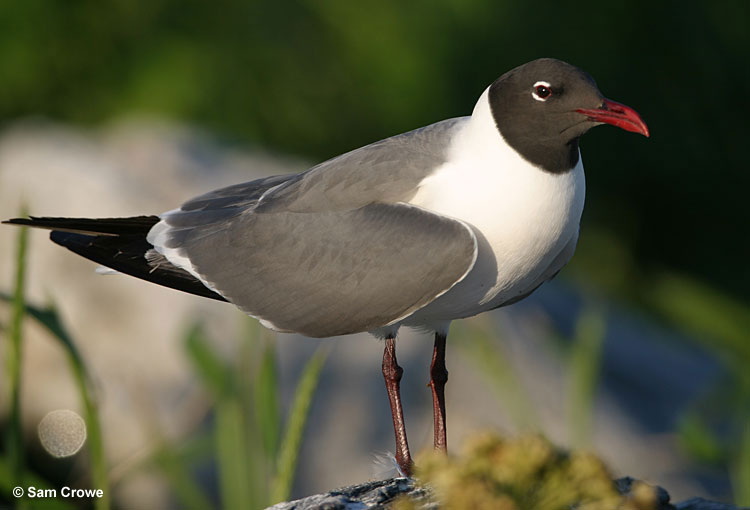
Scientific name: Leucophaeus atricilla
Length: 16.5 inches
Weight: 11 ounces
Wingspan: 40 inches
Song: “rih, ih, ih, ih, ih, ih, rah ha”
The Laughing Gull is a medium-sized gull with a dark gray back, mostly black wingtips, and two white marks above and below the eyes. In breeding plumage, male and female Laughing Gulls have thick, slightly hooked reddish beaks, and black heads.
In winter, they have a dark bill with a reddish tip and only a bit of black on the head. Young birds are like winter adults but have more marks on their heads and darker wings.
Laughing Gulls feed on fish, carrion, berries, small creatures, and other items that they find on beaches and other coastal habitats. These social birds usually occur in flocks and pick up food with their beaks.
They breed in colonies and make bulky, shallow cup nests out of sticks and other vegetation on coastal islands.
The Laughing Gull lives in coastal habitats of the eastern USA, Gulf of Mexico, and the Caribbean south to northern South America.
Key Identifications:
- Medium-sized gull with a dark gray back and wings, two white marks above and below the eyes, and, a black head (summer), or a white head with dark marks (winter).
- Feeds on fish, berries, and many other food items it finds in salt marshes and on beaches.
- Breeds in colonies on coastal islands and makes a bulky, shallow cup nest of sticks on the ground.
- The Laughing Gull is a vocal bird that makes brief laughing sounds, “rih, ih, ih, ih, ih, ih, rah ha”.
Laughing Gulls mostly occur in coastal habitats where they feed on everything from fish to carrion, nestlings, and berries.
Common Gallinule
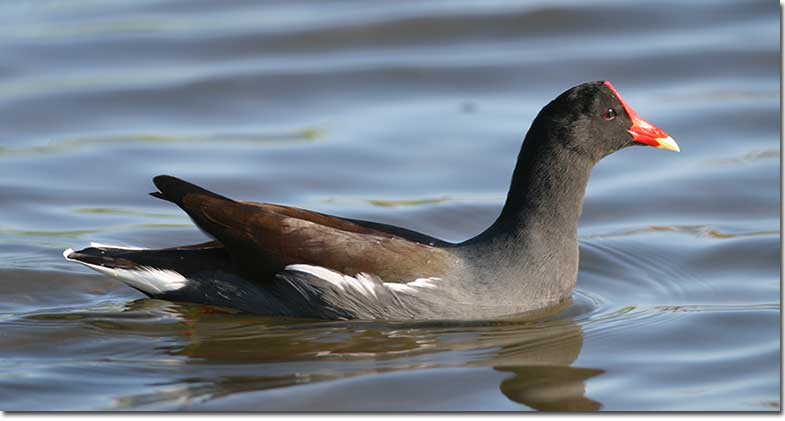
Common Gallinule
Scientific name: Gallinula galeata
Length: 14 inches
Weight: 11 ounces
Wingspan: 21 inches
Song: “ri, did, di , di, di rih, enh, enh”
The Common Gallinule is a chicken-sized plump, black and brownish bird with a stout red and yellow beak, red frontal shield, and white line on each side of its body. Both sexes look alike and have white under their short tail, and longish yellow and reddish legs. Young birds are like adults but have a dull beak and forehead.
They have long toes and creep on the ground through and near marsh habitats. This species also walks on top of marsh vegetation and swims on top of the water. It picks seeds, snails, and other small food items from marsh vegetation above and below the water.
Common Gallinules use stems, leaves, and grass to build a messy cup nest placed in marsh vegetation above the water. These marsh birds live in rice fields and a wide variety of wetland habitats in southeastern Canada, the eastern USA, parts of the southwestern USA, and other areas south to Argentina.
Key Identifications:
- Chicken-like, blackish marsh bird with a reddish beak and white line on each side of its body.
- Feeds on seeds, snails, and other small creatures in and near marsh vegetation.
- Builds a bulky cup nest in marsh vegetation above water.
- The Common Gallinule is a loud and vocal bird that makes a number of odd honking calls. One of its most commonly heard vocalizations sounds like, “ri, did, di , di, di rih, enh, enh”.
They usually occur in pairs or small groups and pick seeds and snails from marsh vegetation. Common Gallinule babies have spurs on their wings so they can climb through vegetation without falling into the water.
Yellow-rumped Warbler
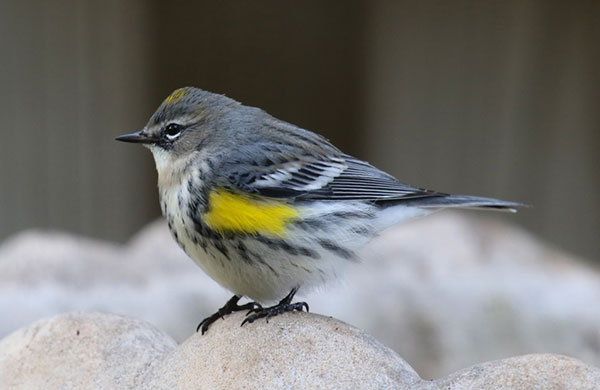
Scientific name: Setophaga coronata
Length: 5.5 inches
Weight: 0.42 ounces
Wingspan: 9.25 inches
Song: “si,sit,sit,sit,sit,sue,sue,sue”
The Yellow-rumped Warbler is a small, blue-gray songbird with a yellow rump, crown, and yellow patches on each side of its breast. It also has two white wing bars, dark marks on the back, and white underparts with blackish markings on its breast and sides.
In summer, this species has a blackish face and white markings above and below the eyes. Females are like males but duller. In winter, both sexes of Yellow-rumped Warblers are duller and have more brownish plumage.
The western subspecies has a yellow throat and more white in the wings.
This species feeds on insects and small berries. It picks food from vegetation and briefly flies into the air to catch bugs in flight.
Yellow-rumped Warbler build small cup nests in conifers in Canada and the northeastern and western USA. They spend the winter in semi-open habitats in Florida and other southern areas in North America.
Key Identifications:
- Small songbird with two pale wing bars and yellow patches on the rump, each side of its breast, and crown.
- Feeds on insects and small berries.
- Builds cup nests in conifers in northern and montane forests.
- The Yellow-rumped Warbler makes a sharp call note, “chup!”, and sings a brief and easy-going warbling song, “si,sit,sit,sit,sit,sue,sue,sue”.
Yellow-rumped Warblers are small, blue-gray or brownish songbirds with two pale wing bars, and yellow patches on the crown, sides of the breast, and rump. In winter, they occur in small flocks that feed on insects and berries in parks and other semi-open habitats. The eastern subspecies is known as the “Myrtle Warbler” and the yellow-throated western subspecies is called, “Audubon’s Warbler”.
Pileated Woodpecker
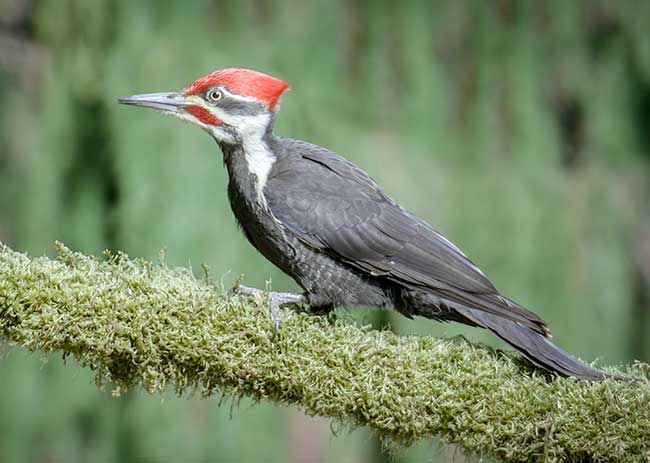
Scientific name: Dryocopus pileatus
Length: 16.5 inches
Weight: 10 ounces
Wingspan: 29 inches
Song: “kek,kek,kek,kek,kek,kek!”
The Pileated Woodpecker is a big, crow-sized black woodpecker with a pointed, red crest, and a black and white face. Males have red extending from the bill to the back of the crest and a red “moustache” mark on their face. Females only have red on the top of the crest.
Both sexes have white on each side of their necks, and a white patch on the front part of each wing. They also have a longish, pointed black tail, and, in flight, show a lot of white on their underwings.
Pileated Woodpeckers are often seen in undulating and direct flight between forest patches. In their search for carpenter ants and insects, they use their strong beaks to make rectangular holes in trees and stumps.
This species nests in tree cavities, usually high above the ground. It lives in mature woodlands in Canada, much of the eastern USA, and parts of the Pacific Northwest.
Key Identifications:
- Big, black, crested woodpecker with some red on its head, and black and white on its face, neck, and underwings.
- Pecks into wood to feeds on ants and other insects.
- Nests in tree cavities in mature forests.
- The Pileated Woodpecker makes a loud, repetitive laughing sound, “kek,kek,kek,kek,kek,kek!”.
Pileated Woodpeckers are big, mostly black woodpeckers with red on their crest and black and white on their face. They peck into wood to forage for ants and other insects and occur in mature forests. This species makes distinctive, large rectangular holes.
Northern Parula
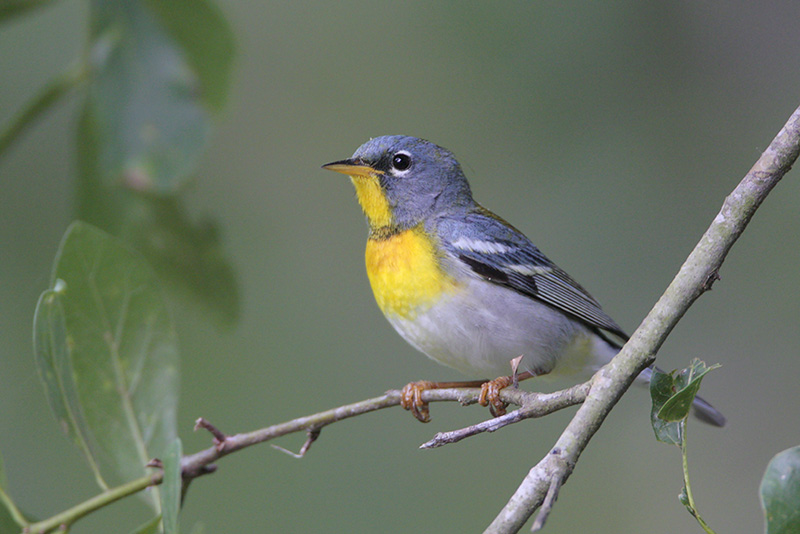
Female Northern Parula. Photograph © Greg Lavaty.
Scientific name: Setophaga americana
Length: 4.5 inches
Weight: 0.3 ounces
Wingspan: 7 inches
Song: “trrrrrrrr-zup”
The Northern Parula is a tiny songbird with gray-blue upperparts, orange-yellow throat and breast, and white belly. It also has an olive patch on its back, two short white wing bars, and a broken white eyering.
Males also have some black on the face and a blackish and dark chestnut patch on the lower part of their throat. Females and young birds resemble males but don’t have any dark marks on the throat and are paler.
This small warbler quickly moves through vegetation to pick insects from foliage and twigs. They build small cup nests with a side entrance in hanging Spanish Moss or lichen. Nests are usually high above the ground, often in a swampy area.
They breed in Florida, with a small portion of their species staying for winter months.
Key Identifications:
- Small warbler bluish above with two short wing bars, deep yellow throat, and a white belly.
- Feeds on small insects.
- Makes a cup nest with a side entrance in lichen and Spanish Moss.
- The Northern Parula makes sharp chip notes and a buzzy, rising, trilling song that “trips over” at the top, “trrrrrrrr-zup”.
Northern Parulas are small blueish warblers with a deep yellow throat and white belly. They forage for insects in bushes and high above the ground and breed in coniferous and mixed forests. In winter, they use all sorts of habitats. This species is the smallest wood-warbler species that occurs in eastern North America.
Carolina Chickadee
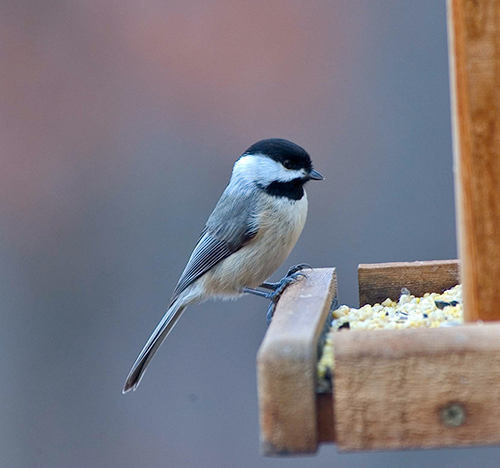
Scientific name: Poecile carolinensis
Length: 4.75 inches
Weight: 0.37 ounces
Wingspan: 7.5 inches
Song: “see-dee, see-dew”
The Carolina Chickadee is a small, cute, grayish and buff bird with a black cap, black throat, and white face. Males and females look the same and have stubby black beaks, strong, blue-gray legs and feet, and some pale edging on the feathers in their wings and tails.
This small bird mostly feeds on insects and seeds. It finds food by foraging with flocks of other small birds and picking small bugs and other items from bark, foliage, and twigs. Carolina Chickadees often hang upside down from twigs while foraging and are regular visitors to bird feeders.
These fun little birds nest in tree cavities and nest boxes, and live in parks, woodlands, and other habitats. As long as enough trees are present, they also commonly live in urban areas.
The Carolina Chickadee is a permanent resident from Maryland and Ohio west to Texas and south to northern Florida.
Key Identifications:
- The Carolina Chickadee is a small gray and buff bird with a smart black cap, black throat, and white face.
- Feeds on small insects and seeds. A regular visitor to bird feeders.
- Nests in tree cavities and nest boxes.
- Carolina Chickadees are vocal birds that make nasal “chick a dee dee dee” calls, and a high-pitched, “see-dee, see-dew”.
The Carolina Chickadee is a small grayish bird with a black cap and throat. They usually occur in small flocks that forage for insects and seeds as they chatter and move through woodlands and park-like habitats. This species uses its excellent memory to recall where it keeps hidden bits of food.
Brown Pelican
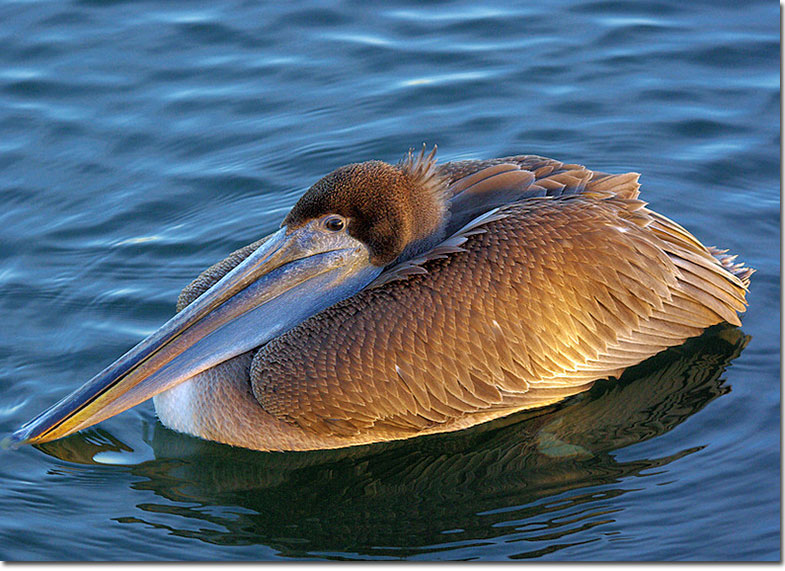
Scientific name: Pelicanus occidentalis
Length: 51 inches
Weight: 8.2 pounds
Wingspan: 79 inches
Song: “rea, reah”
The Brown Pelican is a big, grayish and dark brown pelican with silver highlights on its back and wings. Males and females look alike, have buff on their heads, and a big, pouched beak.
They have dark brown and white necks in summer and all white necks in winter. On the Pacific Coast, Brown Pelicans also have red bill pouches during the breeding season.
Young birds look like dull, gray-brown pelicans with white bellies. These large birds feed on fish in coastal habitats. They catch their food by flying above the water and then folding their wings to dive straight down. After hitting the water with a splash, they snatch the fish with their big, pouched bill.
Brown Pelicans breed in colonies and make large, bulky, platform stick nests on the ground and in trees.
The Brown Pelican lives in coastal waters in many parts of the USA south to the Caribbean and northern South America.
Key Identifications:
- The Brown Pelican is a big, unmistakable, brownish pelican of coastal waters.
- Catches fish after spectacular dives into water.
- Makes big stick nests on the ground and in trees.
- This species is usually quiet but does make some soft, low sounds.
The Brown Pelican is a big, grayish brown pelican that lives in coastal waters. It usually occurs in flocks that forage near shore and needs four pounds of food per day. To protect them while diving into the water, Brown Pelicans have special air sacs.
What Are The Best Ways To Attract Backyard Birds?
-
Regular bird feeders
Putting up and maintaining feeders is one of the easiest ways to attract birds to the backyard. Birdseed mixes are good for bringing in finches, Blue Jays, chickadees, and other small birds. In summer, orange slices and grape jelly are also good ways to attract orioles and some other bird species.
-
Hummingbird feeders and flowering bushes
Maintaining hummingbird feeders with ¼ cup of sugar per each cup of boiled water is the easiest way to attract hummingbirds. For a true hummingbird haven, combine them with Butterfly Bush, sage species, and other flowering bushes.
-
Water features
Birds love to bathe, especially on hot summer days. A fountain, bird bath, or other water feature can attract birds of many species. This is also a good way to attract warblers and other songbirds during migration.
-
Nesting boxes
Put up a nest box or two to bring bluebirds, screech-owls, and other species to the backyard. Make sure to use nest boxes with appropriate-sized holes for the species you want to attract.
-
Native plantings
Giving birds a good place to live is the best thing we can do to attract birds to our backyards. Native plants and trees work best, especially plants that provide cover, berries, seeds, and flowers.
-
Think twice about cutting and raking the lawn
Leaving some cover and leaves provides valuable habitat for insects that birds feed on. Additionally, it helps juncos and sparrows in the winter and other birds during migration and summer. This is also an excellent way to give biodiversity a boost, right in your own backyard.
What Are The Best Places To Watch Wild Birds?
Birds are everywhere but some places are better for watching wild birds than others. While we can see a surprising number of wild birds in our backyards, especially if they are planted with native plants, we find more in places with larger areas of habitat.
Good birding sites can include local parks, especially during migration. However, the best sites for seeing wild birds tend to be nature reserves, wildlife refuges, and other protected areas.
These places are designed to host various types of habitats and are specifically managed to conserve as many bird species as possible.
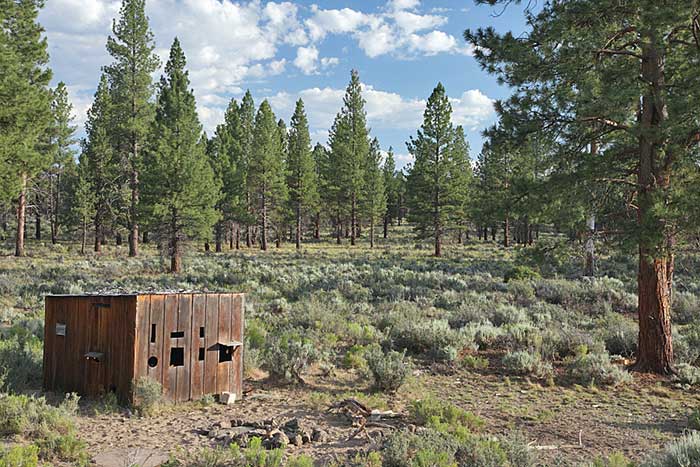
Birds are everywhere, but some places are better for watching wild birds than others
Watching birds in such places is also made easy by the presence of overlooks for scanning lakes and marshes, trails, and visitor centers with information about the latest bird sightings.
Such factors probably make wildlife preserves, refuges, and national parks the best and easiest places for seeing plenty of wild birds.
However, it’s worth keeping in mind that birds go where the habitat is. This is why other good places for seeing wild birds include roads through national forests, state forests, wetland sites, lakes, and rivers.
In general, whether the habitat is desert, grasslands, or forest, any good-sized area of natural habitat will have a nice variety of wild birds to look at. Just remember to take your time and keep watching!
Frequently Asked Questions about Birds of Florida
What is Florida’s most common bird?
The Northern Cardinal is the most common bird in Florida. They can be seen year-round, and are easy to identify by their bright breeding plumage.
How many native birds are in Florida?
There are 517 native birds in Florida.
How many bird species are in Florida?
In total, 552 species of exotic and native birds have been found in Florida.
What is the unique bird in Florida?
What bird is only found in Florida?
The Florida Scrub-Jay is only found in Florida. They only live in scrubby oak woodlands, but due to habitat loss, they are in a vulnerable position.
What bird is Florida famous for?
The American Flamingo, Wood Stork, and Snail Kite are three of several bird species that Florida is famous for.
Does Florida have a lot of birds?
Florida has a lot of birds. Many birds are easily seen in Florida and the state has a bird list of more than 500 species.
Read next: Hawks in FL | Owls in FL | Woodpeckers in FL | Ducks in FL | Hummingbirds in FL
Please let us know your thoughts! Which of these birds have you seen in Florida? Which ones would you love to see? Tell us about your favorite Florida birds in the comments!


